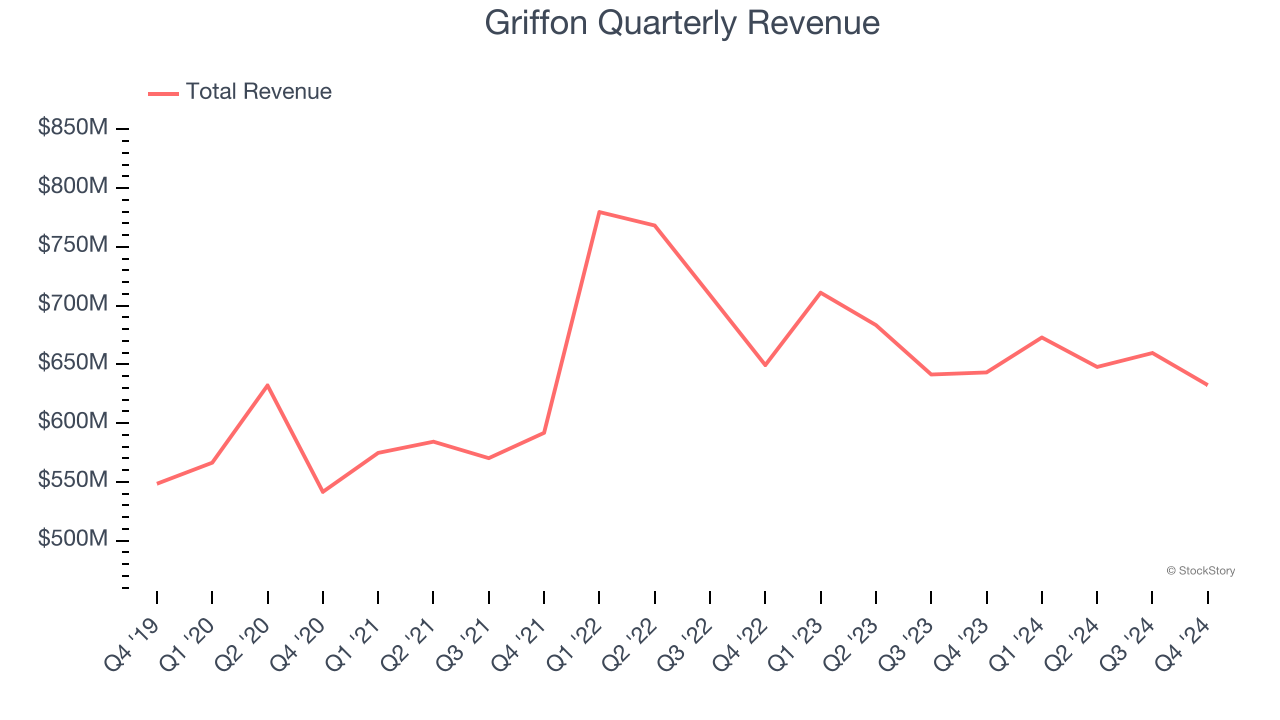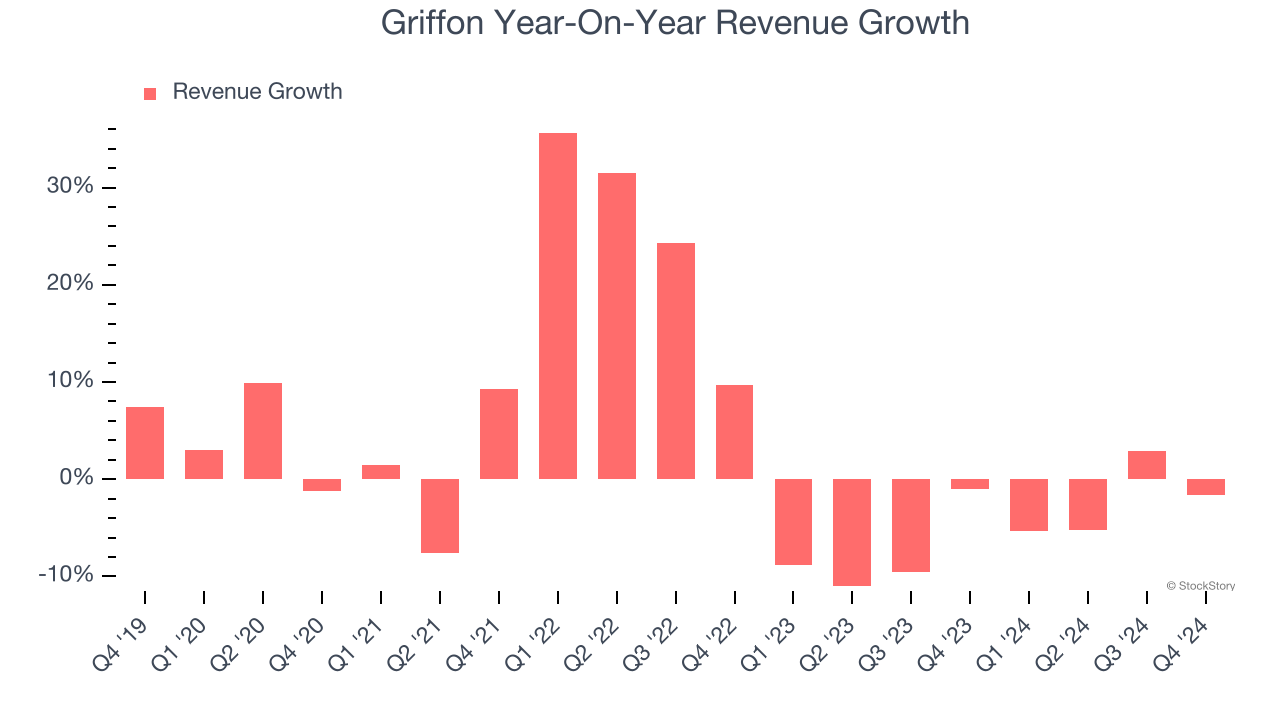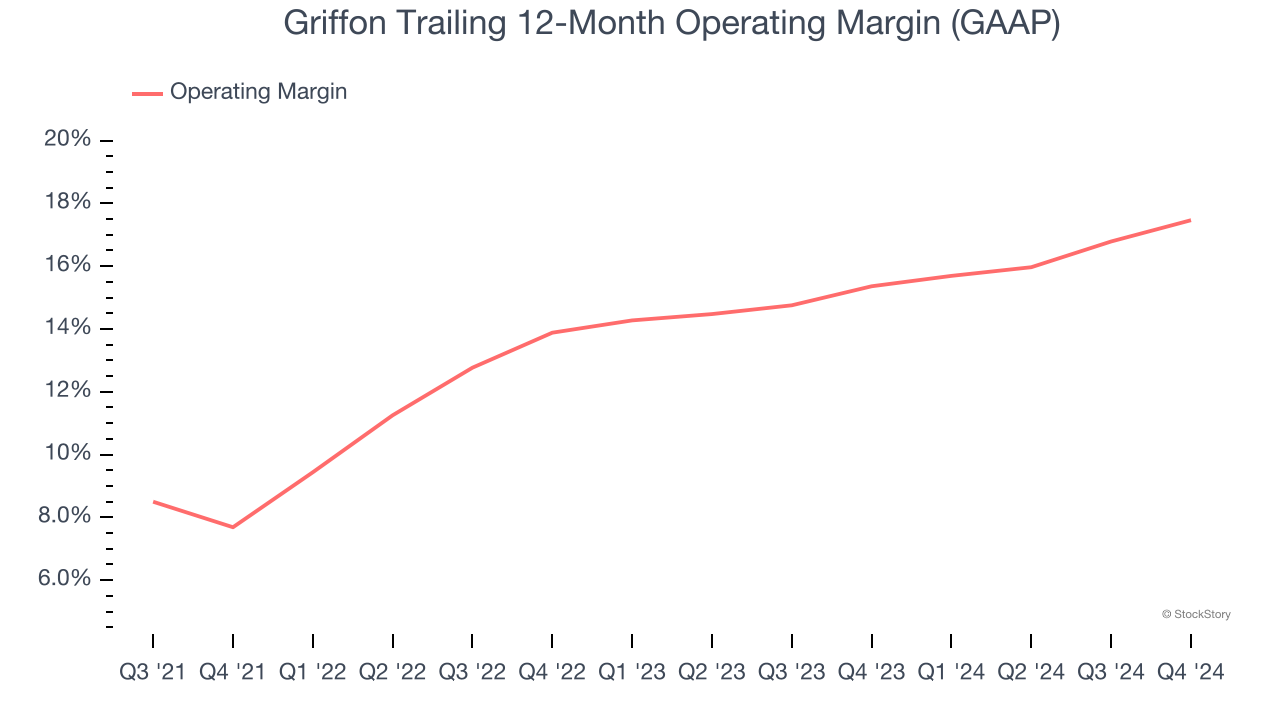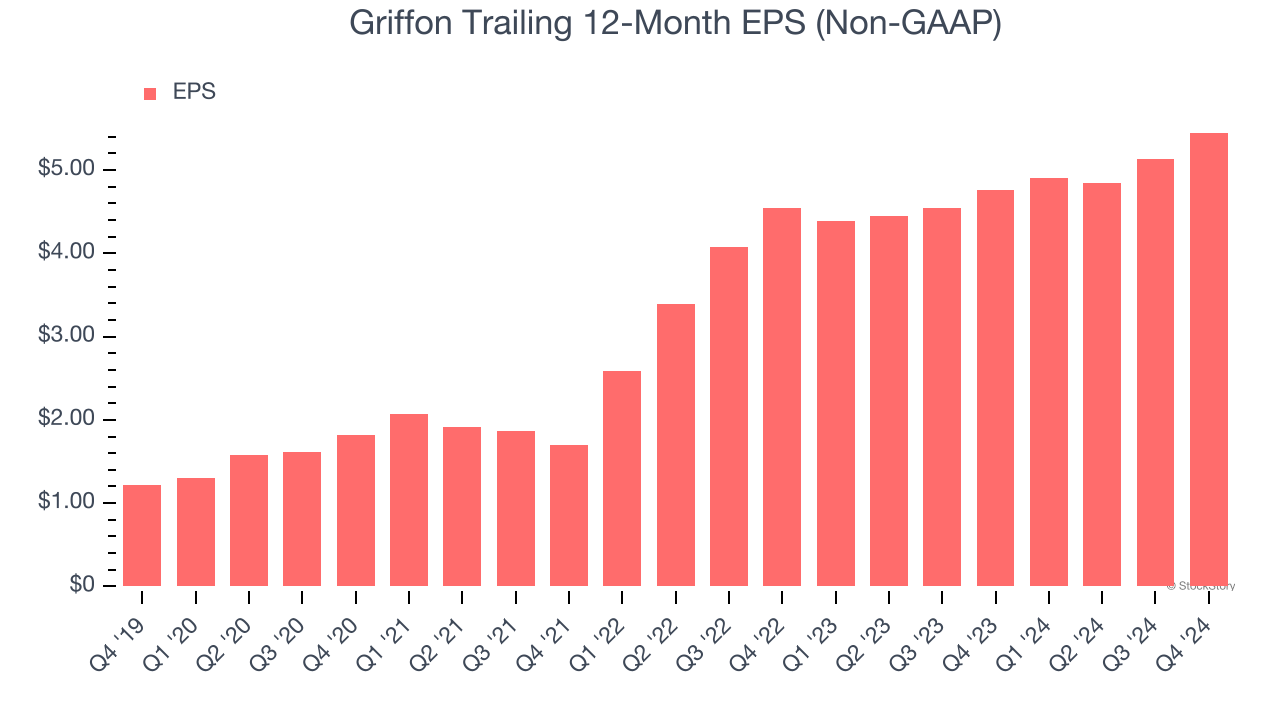
Multi-industry consumer and professional products manufacturer Griffon Corporation (NYSE:GFF) fell short of the market’s revenue expectations in Q4 CY2024, with sales falling 1.7% year on year to $632.4 million. Its non-GAAP profit of $1.39 per share was 16.4% above analysts’ consensus estimates.
Is now the time to buy Griffon? Find out by accessing our full research report, it’s free.
Griffon (GFF) Q4 CY2024 Highlights:
- Revenue: $632.4 million vs analyst estimates of $637.6 million (1.7% year-on-year decline, 0.8% miss)
- Adjusted EPS: $1.39 vs analyst estimates of $1.19 (16.4% beat)
- Adjusted EBITDA: $131.2 million vs analyst estimates of $120 million (20.7% margin, 9.4% beat)
- Operating Margin: 17.7%, up from 15% in the same quarter last year
- Free Cash Flow Margin: 22.6%, up from 20% in the same quarter last year
- Market Capitalization: $3.57 billion
“Fiscal 2025 is off to a strong start, with our first quarter results highlighted by free cash flow of $143 million, continued solid operating performance at Home and Building Products ("HBP"), and improved profitability from our global sourcing expansion initiative at Consumer and Professional Products (“CPP”),” said Ronald J. Kramer, Chairman and Chief Executive Officer.
Company Overview
Initially in the defense industry, Griffon (NYSE:GFF) is a now diversified company specializing in home improvement, professional equipment, and building products.
Home Construction Materials
Traditionally, home construction materials companies have built economic moats with expertise in specialized areas, brand recognition, and strong relationships with contractors. More recently, advances to address labor availability and job site productivity have spurred innovation that is driving incremental demand. However, these companies are at the whim of residential construction volumes, which tend to be cyclical and can be impacted heavily by economic factors such as interest rates. Additionally, the costs of raw materials can be driven by a myriad of worldwide factors and greatly influence the profitability of home construction materials companies.
Sales Growth
A company’s long-term sales performance can indicate its overall quality. Any business can put up a good quarter or two, but many enduring ones grow for years. Over the last five years, Griffon grew its sales at a sluggish 3.1% compounded annual growth rate. This fell short of our benchmark for the industrials sector, but there are still things to like about Griffon.

Long-term growth is the most important, but within industrials, a half-decade historical view may miss new industry trends or demand cycles. Griffon’s history shows it grew in the past but relinquished its gains over the last two years, as its revenue fell by 5.2% annually. 
This quarter, Griffon missed Wall Street’s estimates and reported a rather uninspiring 1.7% year-on-year revenue decline, generating $632.4 million of revenue.
Looking ahead, sell-side analysts expect revenue to grow 1.4% over the next 12 months. While this projection indicates its newer products and services will fuel better top-line performance, it is still below the sector average. At least the company is tracking well in other measures of financial health.
Today’s young investors won’t have read the timeless lessons in Gorilla Game: Picking Winners In High Technology because it was written more than 20 years ago when Microsoft and Apple were first establishing their supremacy. But if we apply the same principles, then enterprise software stocks leveraging their own generative AI capabilities may well be the Gorillas of the future. So, in that spirit, we are excited to present our Special Free Report on a profitable, fast-growing enterprise software stock that is already riding the automation wave and looking to catch the generative AI next.
Operating Margin
Griffon has been an efficient company over the last five years. It was one of the more profitable businesses in the industrials sector, boasting an average operating margin of 13%. This result isn’t too surprising as its gross margin gives it a favorable starting point.
Analyzing the trend in its profitability, Griffon’s operating margin rose by 9.2 percentage points over the last five years, showing its efficiency has meaningfully improved.

This quarter, Griffon generated an operating profit margin of 17.7%, up 2.8 percentage points year on year. Since its gross margin expanded more than its operating margin, we can infer that leverage on its cost of sales was the primary driver behind the recently higher efficiency.
Earnings Per Share
We track the long-term change in earnings per share (EPS) for the same reason as long-term revenue growth. Compared to revenue, however, EPS highlights whether a company’s growth is profitable.
Griffon’s EPS grew at an astounding 34.9% compounded annual growth rate over the last five years, higher than its 3.1% annualized revenue growth. This tells us the company became more profitable on a per-share basis as it expanded.

We can take a deeper look into Griffon’s earnings quality to better understand the drivers of its performance. As we mentioned earlier, Griffon’s operating margin expanded by 9.2 percentage points over the last five years. This was the most relevant factor (aside from the revenue impact) behind its higher earnings; taxes and interest expenses can also affect EPS but don’t tell us as much about a company’s fundamentals.
Like with revenue, we analyze EPS over a shorter period to see if we are missing a change in the business.
For Griffon, its two-year annual EPS growth of 9.4% was lower than its five-year trend. This wasn’t great, but at least the company was successful in other measures of financial health.
In Q4, Griffon reported EPS at $1.39, up from $1.07 in the same quarter last year. This print easily cleared analysts’ estimates, and shareholders should be content with the results. Over the next 12 months, Wall Street expects Griffon’s full-year EPS of $5.45 to grow 5.2%.
Key Takeaways from Griffon’s Q4 Results
We were impressed by how significantly Griffon blew past analysts’ EBITDA expectations this quarter. We were also glad its EPS outperformed Wall Street’s estimates. On the other hand, its revenue slightly missed. Overall, we think this was a decent quarter with some key metrics above expectations. The areas below expectations seem to be driving the move, and shares traded down 2.9% to $72.21 immediately after reporting.
So do we think Griffon is an attractive buy at the current price? If you’re making that decision, you should consider the bigger picture of valuation, business qualities, as well as the latest earnings. We cover that in our actionable full research report which you can read here, it’s free.
